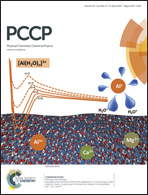Coupled-cluster and density functional theory studies of the electronic 0–0 transitions of the DNA bases†
Abstract
The 0–0 transitions of the electronic excitation spectra of the lowest tautomers of the four nucleotide (DNA) bases have been studied using linear-response approximate coupled-cluster singles and doubles (CC2) calculations. Excitation energies have also been calculated at the linear-response time-dependent density functional theory (TDDFT) level using the B3LYP functional. Large basis sets have been employed for ensuring that the obtained excitation energies are close to the basis-set limit. Zero-point vibrational energy corrections have been calculated at the B3LYP and CC2 levels for the ground and excited states rendering direct comparisons with high-precision spectroscopy measurements feasible. The obtained excitation energies for the 0–0 transitions of the first excited states of guanine tautomers are in good agreement with experimental values confirming the experimental assignment of the energetic order of the tautomers of the DNA bases. For the experimentally detected guanine tautomers, the first excited state corresponds to a π → π* transition, whereas for the tautomers of adenine, thymine, and the lowest tautomer of cytosine the transition to the first excited state has n → π* character. The calculations suggest that the 0–0 transitions of adenine, thymine, and cytosine are not observed in the absorption spectrum due to the weak oscillator strength of the formally symmetry-forbidden transitions, while 0–0 transitions of thymine have been detected in fluorescence excitation spectra.


 Please wait while we load your content...
Please wait while we load your content...